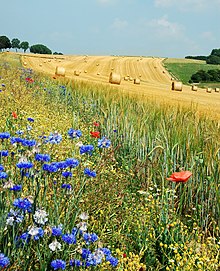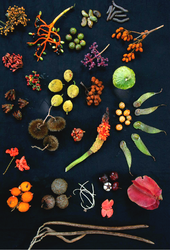Ecosystem services
The balance of evidence
"Ecosystem services are the suite of benefits that ecosystems provide to humanity." The natural species, or biota, are the caretakers of all ecosystems. It is as if the natural world is an enormous bank account of capital assets capable of paying life sustaining dividends indefinitely, but only if the capital is maintained.
These services come in three flavors:
- Provisioning services which involve the production of renewable resources (e.g.: food, wood, fresh water)
- Regulating services which are those that lessen environmental change (e.g.: climate regulation, pest/disease control)
- Cultural services represent human value and enjoyment (e.g.: landscape aesthetics, cultural heritage, outdoor recreation and spiritual significance)
There have been many claims about biodiversity's effect on these ecosystem services, especially provisioning and regulating services. After an exhaustive survey through peer-reviewed literature to evaluate 36 different claims about biodiversity's effect on ecosystem services, 14 of those claims have been validated, 6 demonstrate mixed support or are unsupported, 3 are incorrect and 13 lack enough evidence to draw definitive conclusions.
Services enhanced
Provisioning services
- Greater species diversity of plants increases fodder yield (synthesis of 271 experimental studies).
- Greater genetic diversity of plants (i.e.: diversity within a single species) increases overall crop yield (synthesis of 575 experimental studies). Although another review of 100 experimental studies reports mixed evidence.
- Greater species diversity of trees increases overall wood production (Synthesis of 53 experimental studies). However, there is not enough data to draw a conclusion about the effect of tree trait diversity on wood production.
Regulating services
- Greater species diversity of fish increases the stability of fisheries yield (Synthesis of 8 observational studies)
- Greater species diversity of natural pest enemies decreases herbivorous pest populations (Data from two separate reviews; Synthesis of 266 experimental and observational studies; Synthesis of 18 observational studies. Although another review of 38 experimental studies found mixed support for this claim, suggesting that in cases where mutual intraguild predation occurs, a single predatory species is often more effective
- Greater species diversity of plants decreases disease prevalence on plants (Synthesis of 107 experimental studies)
- Greater species diversity of plants increases resistance to plant invasion (Data from two separate reviews; Synthesis of 105 experimental studies; Synthesis of 15 experimental studies)
- Greater species diversity of plants increases carbon sequestration, but note that this finding only relates to actual uptake of carbon dioxide and not long term storage, see below; Synthesis of 479 experimental studies)
- Greater species diversity of plants increases soil nutrient remineralization (Synthesis of 103 experimental studies)
- Greater species diversity of plants increases soil organic matter (Synthesis of 85 experimental studies)
Services with mixed evidence
Provisioning services
- None to date
Regulating services
- Greater species diversity of plants may or may not decrease herbivorous pest populations. Data from two separate reviews suggest that greater diversity decreases pest populations (Synthesis of 40 observational studies; Synthesis of 100 experimental studies). One review found mixed evidence (Synthesis of 287 experimental studies), while another found contrary evidence (Synthesis of 100 experimental studies.)
- Greater species diversity of animals may or may not decrease disease prevalence on those animals (Synthesis of 45 experimental and observational studies), although a 2013 study offers more support showing that biodiversity may in fact enhance disease resistance within animal communities, at least in amphibian frog ponds. Many more studies must be published in support of diversity to sway the balance of evidence will be such that we can draw a general rule on this service.
- Greater species and trait diversity of plants may or may not increase long term carbon storage (Synthesis of 33 observational studies)
- Greater pollinator diversity may or may not increase pollination (Synthesis of 7 observational studies), but a publication from March 2013 suggests that increased native pollinator diversity enhances pollen deposition (although not necessarily fruit set as the authors would have you believe, for details explore their lengthy supplementary material).
Services hindered
Provisioning services
- Greater species diversity of plants reduces primary production (Synthesis of 7 experimental studies)
Regulating services
- Greater genetic and species diversity of a number of organisms reduces freshwater purification (Synthesis of 8 experimental studies, although an attempt by the authors to investigate the effect of detritivore diversity on freshwater purification was unsuccessful due to a lack of available evidence (only 1 observational study was found
Provisioning services
- Effect of species diversity of plants on biofuel yield (In a survey of the literature, the investigators only found 3 studies)
- Effect of species diversity of fish on fishery yield (In a survey of the literature, the investigators only found 4 experimental studies and 1 observational study)
Regulating services
- Effect of species diversity on the stability of biofuel yield (In a survey of the literature, the investigators did not find any studies)
- Effect of species diversity of plants on the stability of fodder yield (In a survey of the literature, the investigators only found 2 studies)
- Effect of species diversity of plants on the stability of crop yield (In a survey of the literature, the investigators only found 1 study)
- Effect of genetic diversity of plants on the stability of crop yield (In a survey of the literature, the investigators only found 2 studies)
- Effect of diversity on the stability of wood production (In a survey of the literature, the investigators could not find any studies)
- Effect of species diversity of multiple taxa on erosion control (In a survey of the literature, the investigators could not find any studies – they did however find studies on the effect of species diversity and root biomass)
- Effect of diversity on flood regulation (In a survey of the literature, the investigators could not find any studies)
- Effect of species and trait diversity of plants on soil moisture (In a survey of the literature, the investigators only found 2 studies)
Other sources have reported somewhat conflicting results and in 1997 Robert Costanza and colleagues reported the estimated global value of ecosystem services (not captured in traditional markets) at an average of $33 trillion annually.
Since the stone age, species loss has accelerated above the average basal rate, driven by human activity. Estimates of species losses are at a rate 100-10,000 times as fast as is typical in the fossil record. Biodiversity also affords many non-material benefits including spiritual and aesthetic values, knowledge systems and education.
Agriculture
Agricultural diversity can be divided into two categories: intraspecific diversity, which includes the genetic variety within a single species, like the potato (Solanum tuberosum) that is composed of many different forms and types (e.g.: in the U.S. we might compare russet potatoes with new potatoes or purple potatoes, all different, but all part of the same species, S. tuberosum).
The other category of agricultural diversity is called interspecific diversity and refers to the number and types of different species. Thinking about this diversity we might note that many small vegetable farmers grow many different crops like potatoes and also carrots, peppers, lettuce etc.
Agricultural diversity can also be divided by whether it is ‘planned’ diversity or ‘associated’ diversity. This is a functional classification that we impose and not an intrinsic feature of life or diversity. Planned diversity includes the crops which a farmer has encouraged, planted or raised (e.g.: crops, covers, symbionts and livestock, among others), which can be contrasted with the associated diversity that arrives among the crops, uninvited (e.g.: herbivores, weed species and pathogens, among others).
The control of associated biodiversity is one of the great agricultural challenges that farmers face. On monoculture farms, the approach is generally to eradicate associated diversity using a suite of biologically destructive pesticides, mechanized tools and transgenic engineering techniques, then to rotate crops. Although some polyculture farmers use the same techniques, they also employ integrated pest management strategies as well as strategies that are more labor-intensive, but generally less dependent on capital, biotechnology and energy.
Interspecific crop diversity is, in part, responsible for offering variety in what we eat. Intraspecific diversity, the variety of alleles within a single species, also offers us choice in our diets. If a crop fails in a monoculture, we rely on agricultural diversity to replant the land with something new. If a wheat crop is destroyed by a pest we may plant a hardier variety of wheat the next year, relying on intraspecific diversity. We may forgo wheat production in that area and plant a different species altogether, relying on interspecific diversity. Even an agricultural society which primarily grows monocultures, relies on biodiversity at some point.
- The Irish potato blight of 1846 was a major factor in the deaths of one million people and the emigration of about two million. It was the result of planting only two potato varieties, both vulnerable to the blight, Phytophthora infestans, which arrived in 1845
- When rice grassy stunt virus struck rice fields from Indonesia to India in the 1970s, 6,273 varieties were tested for resistance. Only one was resistant, an Indian variety and known to science only since 1966. This variety formed a hybrid with other varieties and is now widely grown.
- Coffee rust attacked coffee plantations in Sri Lanka, Brazil and Central America in 1970. A resistant variety was found in Ethiopia. The diseases are themselves a form of biodiversity.
Monoculture was a contributing factor to several agricultural disasters, including the European wine industry collapse in the late 19th century and the US southern corn leaf blight epidemic of 1970.
Although about 80 percent of humans' food supply comes from just 20 kinds of plants, humans use at least 40,000 species. Many people depend on these species for food, shelter and clothing. Earth's surviving biodiversity provides resources for increasing the range of food and other products suitable for human use, although the present extinction rate shrinks that potential.
Human health
Biodiversity's relevance to human health is becoming an international political issue, as scientific evidence builds on the global health implications of biodiversity loss. This issue is closely linked with the issue of climate change, as many of the anticipated health risks of climate change are associated with changes in biodiversity (e.g. changes in populations and distribution of disease vectors, scarcity of fresh water, impacts on agricultural biodiversity and food resources etc.) This is because the species most likely to disappear are those that buffer against infectious disease transmission, while surviving species tend to be the ones that increase disease transmission, such as that of West Nile Virus, Lyme disease and Hantavirus, according to a study done co-authored by Felicia Keesing, an ecologist at Bard College and Drew Harvell, associate director for Environment of the Atkinson Center for a Sustainable Future (ACSF) at Cornell University.
The growing demand and lack of drinkable water on the planet presents an additional challenge to the future of human health. Partly, the problem lies in the success of water suppliers to increase supplies and failure of groups promoting preservation of water resources. While the distribution of clean water increases, in some parts of the world it remains unequal. According to 2008 World Population Data Sheet, only 62% of least developed countries are able to access clean water.
Some of the health issues influenced by biodiversity include dietary health and nutrition security, infectious disease, medical science and medicinal resources, social and psychological health. Biodiversity is also known to have an important role in reducing disaster risk and in post-disaster relief and recovery efforts.
Biodiversity provides critical support for drug discovery and the availability of medicinal resources. A significant proportion of drugs are derived, directly or indirectly, from biological sources: at least 50% of the pharmaceutical compounds on the US market are derived from plants, animals and micro-organisms, while about 80% of the world population depends on medicines from nature (used in either modern or traditional medical practice) for primary healthcare. Only a tiny fraction of wild species has been investigated for medical potential. Biodiversity has been critical to advances throughout the field of bionics. Evidence from market analysis and biodiversity science indicates that the decline in output from the pharmaceutical sector since the mid-1980s can be attributed to a move away from natural product exploration ("bioprospecting") in favor of genomics and synthetic chemistry, indeed claims about the value of undiscovered pharmaceuticals may not provide enough incentive for companies in free markets to search for them because of the high cost of development; meanwhile, natural products have a long history of supporting significant economic and health innovation. Marine ecosystems are particularly important, although inappropriate bioprospecting can increase biodiversity loss, as well as violating the laws of the communities and states from which the resources are taken.
Business and industry
Many industrial materials derive directly from biological sources. These include building materials, fibers, dyes, rubber and oil. Biodiversity is also important to the security of resources such as water, timber, paper, fiber and food. As a result, biodiversity loss is a significant risk factor in business development and a threat to long term economic sustainability.
Leisure, cultural and aesthetic value
Biodiversity enriches leisure activities such as hiking, birdwatching or natural history study. Biodiversity inspires musicians, painters, sculptors, writers and other artists. Many cultures view themselves as an integral part of the natural world which requires them to respect other living organisms.
Popular activities such as gardening, fishkeeping and specimen collecting strongly depend on biodiversity. The number of species involved in such pursuits is in the tens of thousands, though the majority do not enter commerce.
The relationships between the original natural areas of these often exotic animals and plants and commercial collectors, suppliers, breeders, propagators and those who promote their understanding and enjoyment are complex and poorly understood. The general public responds well to exposure to rare and unusual organisms, reflecting their inherent value.
Philosophically it could be argued that biodiversity has intrinsic aesthetic and spiritual value to mankind in and of itself. This idea can be used as a counterweight to the notion that tropical forests and other ecological realms are only worthy of conservation because of the services they provide.
Ecological services
It plays a part in regulating the chemistry of our atmosphere and water supply. Biodiversity is directly involved in water purification, recycling nutrients and providing fertile soils. Experiments with controlled environments have shown that humans cannot easily build ecosystems to support human needs; for example insect pollination cannot be mimicked, and that activity alone represented between $2.1-14.6 billions in 2003





No comments:
Post a Comment